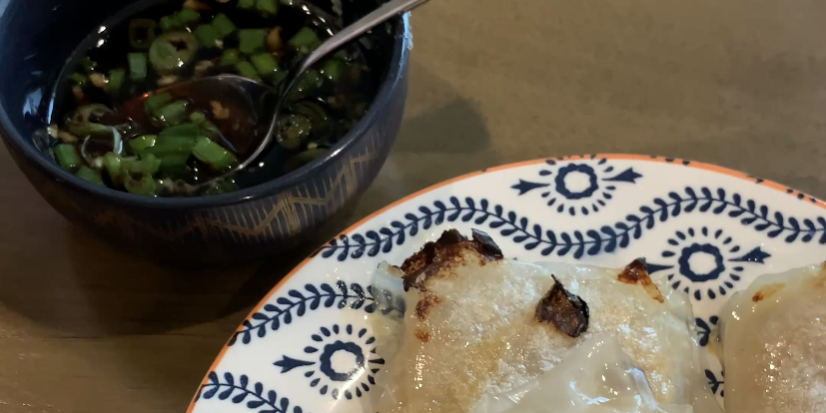If you’ve ever had potstickers, gyoza, or any kind of dumplings, you know they’re a delicious comfort food. One of my older brothers learned to make Chinese potstickers from a neighbor and he taught our family to make them as well. It’s a family favorite and cherished memory making those dumplings. My husband Ryan’s family similarly would make Japanese gyoza often when he was growing up, as his uncle learned to make them while living in Japan for a couple years. When we got married, we discovered the two recipes we learned were relatively similar and we continued to make dumplings together in our own family.
We have enjoyed them often together until recently when Ryan stopped being able to tolerate wheat/gluten (we still haven’t been able to figure out what’s up with that as his tests came back negative for allergies and celiac). Since gyoza is one of his favorite foods, I thought I’d give rice paper a try instead of using wanton wrappers, and a soy sauce replacement instead of traditional soy sauce as it normally contains gluten.
These dumplings actually turned out so good, and were easier to put together than I expected! The rice paper gets really nice crunchy texture, and the flavors inside blend well together for a decadent and savory meal or snack.
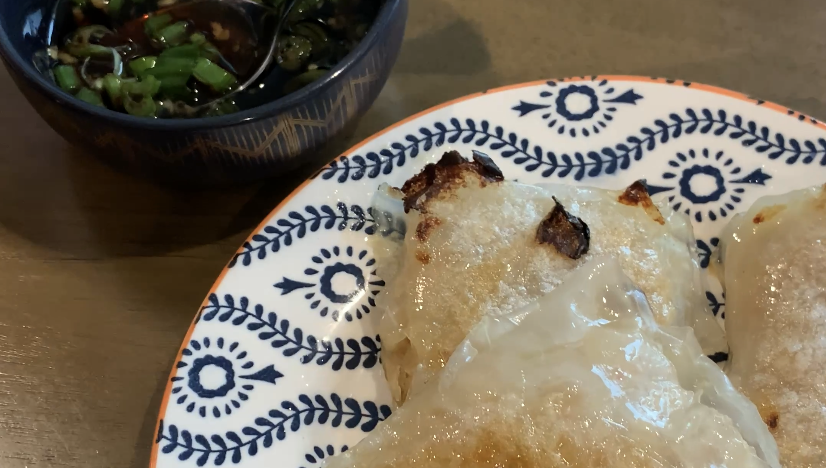
What Makes This Recipe So Great
- Gluten Free: This recipe utilizes rice paper instead of wanton wrappers and coconut aminos or liquid soy aminos instead of soy sauce.
- Easy To Make: All you have to do is chop up your veggies, combine the mixture, and then double wrap in wet rice paper before frying. It’s a little bit of prep, but it doesn’t take too long with the right tools.
- It’s Delicious: These had the same great flavor as traditional dumplings and the crunch of the fried rice paper just adds to the experience.
Ingredients & How to Substitute
- Cabbage – This is the bulk of the filling, as I describe later, you really need to make sure you remove as much water from the cabbage as possible so your dumplings don’t turn out soggy. A great alternative I love to use is chopped cilantro instead of cabbage if you’re a cilantro lover.
- Carrot – Adds a little color and flavor to the dumplings
- Garlic – An essential ingredient for the right flavor, but I’ve heard of a few people who can’t tolerate garlic, in which case just skip it.
- Ginger – Another essential ingredient. I really enjoy the flavor of fresh ginger added to recipes.
- Ground Pork – You can do ground beef, ground chicken, or if you want to make it vegan you can use tofu or diced mushrooms – if you go with a vegan option I recommend frying the filling mixture before putting it in the rice paper for a better flavor.
- Sesame Seed Oil – A little goes a long way, again it ads a really good flavor to the dumplings. If you can’t have sesame, you could add a different oil instead.
- Liquid Aminos – I’ve found liquid aminos to be an adequate substitute for soy sauce in our every day cooking. If you can’t have soy or gluten, I would recommend coconut aminos instead. If you can do soy and wheat/gluten, then soy sauce is actually the preferred ingredient!
- Rice Paper – This will be your wrapper, you’ll need 2 wraps for each dumpling to double wrap it so it can get nice and crispy and hold itself together well.
- Rice Vinegar – This is used in the dipping sauce, rice vinegar is best, but you could use a white vinegar instead if necessary.
- Sugar – This helps your dipping sauce to not turn out too bitter as it balances out the vinegar. You only need a little bit. I like to use coconut sugar.
- Green Onion – The green onion isn’t necessary for the sauce, but I like to add the green parts of the green onion for some extra flavor!
Some Recipe Tips
You really want to chop your vegetables as finely as possible, even smaller than you think they need to be. This is especially important for the cabbage. Your cabbage also needs to have as much water removed from it as possible. You do this by salting your minced cabbage and letting it sit a while to draw the water out, and then squeezing the water out of the cabbage. This is the most tedious part of the recipe.
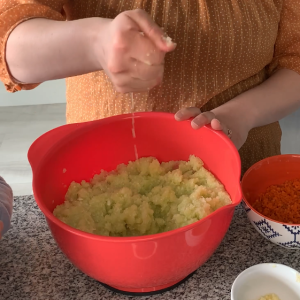
Here’s how much water I was able to remove from a whole head of cabbage:
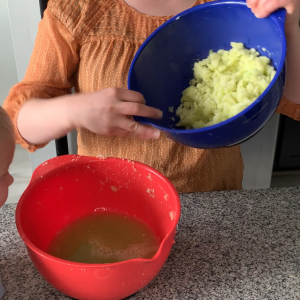
Folding the Rice Paper
Make sure your rice paper is pliable before trying to wrap the meat filling. You don’t want it so wet it falls apart, but wet enough to be bendy without cracking.
1. Chose one of the four sides and fold the rice paper over the filling.
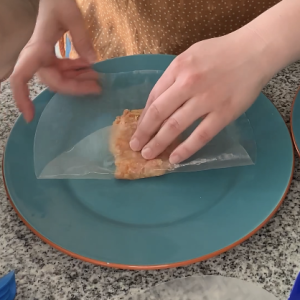
2. Fold the opposite side from your first fold over the filling.
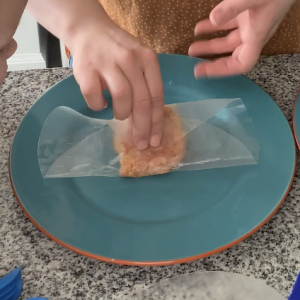
3. Choose either of the two remaining sides to fold over the filling.
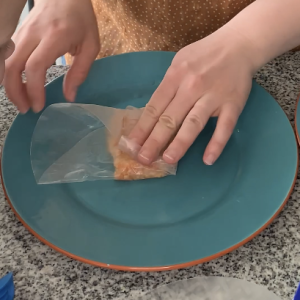
4. Fold the final side over the filling. The filling should be completely enclosed.
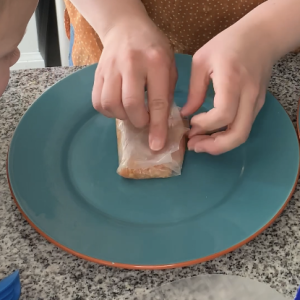
5. Wet another rice paper, place the already enclosed dumpling in the middle with the original folds pointing down and repeat steps 1 – 4 with the second sheet of rice paper.
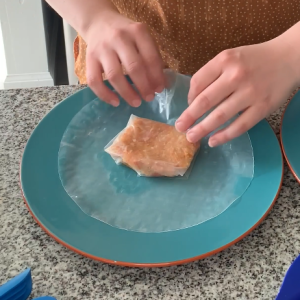
Checking For Doneness
You want your rice paper to get nice and crispy, and you also want your meat to get cooked through. I like to use a meat thermometer to make sure it is fully cooked through by poking into the dumplings at the thickest part. Ground pork should reach a temperature of 160 degrees.
This Recipe Includes A Top 10 Allergen:
Check the Ingredients and Substitutions list above for easy ways to make this safe for you!


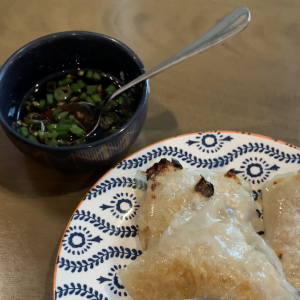
Rice Paper Pork Dumplings
Ingredients
Rice Paper Dumplings
- 1/2 head cabbage finely minced
- salt
- 1 large carrot finely grated
- 2-3 cloves garlic pressed
- 1-2 inches long fresh ginger finely grated
- 1/2 lb ground pork
- 1 tbsp sesame seed oil
- 1-2 tbsp liquid aminos
- 32 rice paper wraps
- 1 tbsp sesame seed oil for cooking
Dipping Sauce
- 1 clove garlic pressed
- 1/4 cup liquid aminos
- 1/4 cup rice vinegar
- 1 pinch sugar to taste
- 1 green onion chopped
Instructions
- Make sure you cabbage is minced extremely finely - I like to use a food processor to get it minced really small. After mincing, add it to a bowl in layers, salting each layer liberally in between and let sit. The salt helps pull out the water from the cabbage to prevent your dumplings from being soggy.
- Once your cabbage is all chopped really small and salted, squeeze out hand fulls at a time to remove the water and place the squeezed cabbage into a new bowl - you can also use a really fine cheese cloth for this part to squeeze out all the water.
- Mince your carrots extremely finely and add to the bowl with the cabbage.
- Add your pork, pressed garlic, minced ginger, sesame oil, and liquid aminos to the same bowl and mix with your hands.
- Wet a rice paper wrapper and place on a damp surface.
- Add about 2 tbsp of the filling in a square shape in the middle of the rice paper.
- Fold each side of your rice paper over the filling - see note above about how to fold it.
- Wet a second rice paper wrapper and place the original wrapped dumpling in the center and wrap again so that your dumpling is double wrapped with two wrappers.
- Repeat until you've wrapped all your dumplings.
- Heat a non-stick pan over medium high heat then add a little sesame oil for cooking.
- Place the dumplings in the pan in a single layer so they're not touching and cook for 3-4 minutes, then flip and cook for another 3-4 minutes until the pork is cooked through and the rice paper is a crispy golden brown. I like to add a tsp of water and cover with a lid for 3 minutes after flipping them, and then let finish cooking uncovered for the last minute, but if you want an even crispier dumpling don't add this step - just make sure your pork reaches an internal temperature of 160 degrees.
- Mix the dipping sauce ingredients together and serve with the dumplings.
